
The President’s Message:
There will be no meeting on Wednesday, February 14, 2024.
Our next meeting will be on Wednesday, March 13th
at 7:00 PM. I am pleased to
announce that our speaker will be Patrick Falci. He is a fine actor,
devoted historian, and enthusiastic lecturer.
Patrick is well-known for his role as General A.P. Hill in the
movie
Gettysburg.
In addition to acting, he was also chief historical advisor for
Gettysburg
and
Gods and Generals.
Because of his vast knowledge of history, John Jakes asked
Patrick to vet the manuscripts for
On Secret
Service
and
Charleston.
Patrick will be presenting the
Four Interments of General A.P. Hill
or
You Cannot Keep a Good Man Down.
I know that this will be a terrific program.
All guests are welcome.
I will be baking General Robert E. Lee’s favorite pound cake and
serving it after the program.
Gerridine LaRovere
January
10, 2024 Program:
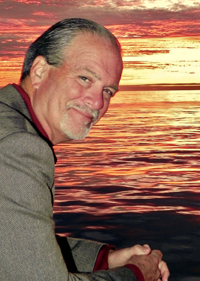 For
the 21st
time, Robert Macomber treated our Round Table to a great presentation.
Although most of us
are quite familiar with Robert, for our new members he is the author of
the “Honor” series of historical novels.
The series is now complete with the publication of
Full Naval Honors,
the 17th
book. Robert’s books tell
the story of the late 19th
and early 20th
century via the fictional character of Peter Wake, USN. For
the 21st
time, Robert Macomber treated our Round Table to a great presentation.
Although most of us
are quite familiar with Robert, for our new members he is the author of
the “Honor” series of historical novels.
The series is now complete with the publication of
Full Naval Honors,
the 17th
book. Robert’s books tell
the story of the late 19th
and early 20th
century via the fictional character of Peter Wake, USN.
Robert has been the recipient of the Patrick D. Smith Literary Award,
the American Library Association’s W.Y. Boyd Literary Award, a Gold and
Silver Medal winner in Popular Fiction from the Florida Book Awards, and
a host of other accolades spanning over two decades.
He has earned rare experiences like being Distinguished Lecturer
at NATO HQs [Belgium], and, for ten years, was invited into the
Distinguished Military Author Series, Center for Army Analysis [Ft.
Belvoir]. Robert was named
Florida Author of the Year in 2020 by the FL Writers Association, and is
a captivating storyteller helping spread a love for history!
The presentation focused on the yacht
America,
the Civil War, and Florida.
The lecture opened with a question: What do
you think of when you hear of the
America’s Cup?
We responded with suggestions like Dennis Connor, rich guys, the
New York Yacht Club. Robert
explained that this talk will be about the schooner
America
and what she did during the Civil War in the State of Florida.
In 1851 the Royal Yacht Squadron proposed a race to determine the
fastest yacht in Britain.
They did not expect a foreign entry, but when
America
showed up there was nothing in the rules to forbid her entrance.
The ship was constructed to be the fastest yacht in the States
having just built in Brown’s shipyard and sailed across the Atlantic.
When they arrived, they had little time for adjustment, so, much
to the miffed officials of the RYS, the race was on.
And this new entry sailed the course and finished well ahead of
the entire fleet.
with a question: What do
you think of when you hear of the
America’s Cup?
We responded with suggestions like Dennis Connor, rich guys, the
New York Yacht Club. Robert
explained that this talk will be about the schooner
America
and what she did during the Civil War in the State of Florida.
In 1851 the Royal Yacht Squadron proposed a race to determine the
fastest yacht in Britain.
They did not expect a foreign entry, but when
America
showed up there was nothing in the rules to forbid her entrance.
The ship was constructed to be the fastest yacht in the States
having just built in Brown’s shipyard and sailed across the Atlantic.
When they arrived, they had little time for adjustment, so, much
to the miffed officials of the RYS, the race was on.
And this new entry sailed the course and finished well ahead of
the entire fleet.
Among the spectators that day was none other than Queen Victoria
herself. All of the members
of the RYS were nobles, dukes and earls etc., and the collective viewers
were apoplectic at the sight of this common vessel sailed by commoners.
The following dialog entered sailing lore that
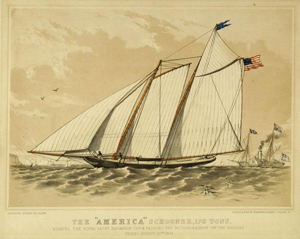 day.
Queen Victoria asked who was second, and received the famous
reply: "There is no second, your Majesty."
The trophy, now called the
America’s Cup,
resided for the next 132 years in the New York Yacht Club.
You would think that the winners would take that schooner all
over the world and race it as an example of yachting supremacy.
They did not do that.
Six months later they sold the boat to a Brit, who changed the
name and successfully raced it for the next ten years.
It changed hands a number of times until Lord Henry Edward Decie
brought it to Jacksonville, FL to become the property of the Confederate
States of America. day.
Queen Victoria asked who was second, and received the famous
reply: "There is no second, your Majesty."
The trophy, now called the
America’s Cup,
resided for the next 132 years in the New York Yacht Club.
You would think that the winners would take that schooner all
over the world and race it as an example of yachting supremacy.
They did not do that.
Six months later they sold the boat to a Brit, who changed the
name and successfully raced it for the next ten years.
It changed hands a number of times until Lord Henry Edward Decie
brought it to Jacksonville, FL to become the property of the Confederate
States of America.
The fast schooner was first used as a means of transporting Confederate
officials from North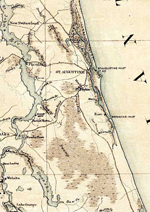 America to London. Many
trips were made by running the blockade out and running the blockade in.
Decie was in command of the vessel the whole time.
On his third trip the English Lord officially sells the ship to
the Confederate Navy for use as a blockade runner.
About that time the US Army and Navy started to close in on
Jacksonville; a city that changed hands five times.
The joke was that families in town had two sets of flags.
America to London. Many
trips were made by running the blockade out and running the blockade in.
Decie was in command of the vessel the whole time.
On his third trip the English Lord officially sells the ship to
the Confederate Navy for use as a blockade runner.
About that time the US Army and Navy started to close in on
Jacksonville; a city that changed hands five times.
The joke was that families in town had two sets of flags.
The schooner was moved up the St. Johns River to Palaka to keep it out
of Union hands. From people
along the river, the US Army begins to hear rumors that a famous
blockade runner is up river.
And that is the same ship the won the
America’s Cup.
It is not really believed, but there is one lieutenant who wants
to check it out on his own.
Now young officers, on both sides, had a bit more freedom to make
decisions on their own in those days.
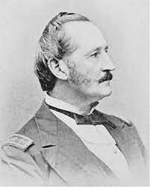 The
lieutenant involved was Thomas Stevens in command of a gunboat,
USS Ottawa.
So, on his own he decided to see if the rumors were true.
He steams up stream and when he gets to Palaka a pro-Union person
tells Stevens that in addition to the schooner
America,
there is a steamer there too.
They are sitting on a tributary called Dunns Creek.
Now
Ottawa
is deep in hostile territory.
There were artillery batteries in Palaka, but they sailed right
past and were never fired upon. The
lieutenant involved was Thomas Stevens in command of a gunboat,
USS Ottawa.
So, on his own he decided to see if the rumors were true.
He steams up stream and when he gets to Palaka a pro-Union person
tells Stevens that in addition to the schooner
America,
there is a steamer there too.
They are sitting on a tributary called Dunns Creek.
Now
Ottawa
is deep in hostile territory.
There were artillery batteries in Palaka, but they sailed right
past and were never fired upon.
Following the pro-Union man Stevens finds
America
that the Confederate had tried to scuttle.
While the steamer was totally under water, the schooner was only
partly down. Note that the
image on the left was the lieutenant as an older officer much later in
his career. While it was
true that Stevens was acting on his own, that does not mean that he did
not keep his superior officers informed.
In this case it was Admiral S.F. Du Pont.
Robert likes to quote from primary sources.
Here is the report:
U.S. Gun Boat Ottawa
Off Jacksonville Fla Mar 28/62
To Flag Officer S.F. DuPont
Com'dg South Atl'c Blk'dg Squadron
Sir
I returned this morning with the launch and 1st cutter of the Wabash and
the Steamer Darlington and Ellen from Dunn's Creek with the Yacht
America which after a weeks hard labor and valuable assistance of Lieut
Irwin, Act'g Master Budd and 1st Asst Engineer Dungan, I succeeded in
raising and bringing to this place, - where I shall keep her awaiting
your further instructions. She is without ground tackle or sails &
almost evrything(sic) else, but her lower masts, bowsprit, gaffs, and
some light spars,_ I sent the Darlington with the boats of the Wabash,
to St Augustine apprehending that you may have use for them. If not and
I can have there(sic) services, I purpose to go to Hass Creek and raise
the Str. St Marys, in which I have
no doubt we shall succeed._ Further up the St Johns River there is a
large amount of floating property, which is of value to the rebels, and
will be of great use to the US Government.
Well, if you are the Admiral, and things have not been going well, this
is a breath of fresh air.
On April 23, 1862 Stevens sends another report.
Sir: As you intimated it would be interesting to know more of the
circumstances connected with the recovery of the yacht America than was
contained in my official report, I have to inform you that the day after
the occupation of Jacksonville I proceeded up the river as far as
Palatka, and there met a person who informed me in general terms as to
her whereabouts and that of the steamer Mary’s. On my way down on board
the Ellen, a boat was discovered with two persons in it, to which we
gave chase, when as we neared the shore the boat was abandoned. Upon
searching the boat a letter was discovered from a Mr. Hemming, the
person who was employed to sink the yacht and the steamer, giving all
the information desired. I reached Jacksonville the same evening, and
the next morning I started in the Darlington, with the Ellen and the
launches of the Wabash, for Dunn’s Creek where I found the yacht sunk in
about 3 fathoms of water, only her port rail being above water. Leaving
the Ellen to protect her from any further injury, I proceeded on in the
Darlington, with the two boats of the Wabash, through Dunn’s Lake into
Haw Creek, a distance of about 140 miles from Palatka, and there found
the St. Mary's, a fine and valuable steamer, also sunk.
As we had no suitable purchases to raise the vessels, I returned to
Jacksonville in the Darlington for them, leaving the Ellen with the
boats named, alongside of the yacht to make preparations for raising
her. Finally, after procuring such imperfect means as I could find, and
after a week’s hard and laborious effort on the part of all the command,
our efforts were successful in raising the America, and I have to report
her safe arrival in this place, where she was towed by the Ottawa, and
where she awaits your orders.
The America was brought to Jacksonville by a Lord Dacy, and, I am well
informed, was sold to the Confederate Government some four months ago
(at which time she ran the blockade) for the sum of $60,000. It is
asserted and generally believed she was bought by the rebels for the
purpose of carrying Slidell and Mason to England.
Now Slidell and Mason actually made the voyage on another vessel, but
they wanted to use the schooner
America
because she was so fast.
Bob had one more document to read.
It was from the Admiral in Port Royal aboard USS Wabash on April
5, 1862:
Sir: I have not had an opportunity to write to you since the receipt of
your communication of 28th ultimo, informing me of your recovery of the
yacht America.
I beg you to receive my commendations and congratulations on this
interesting service in the performance of which you have shown so much
untiring determination and skill. I have received from Lt. Irwin, of
whom you have spoken so favorably in your report, a full account of the
event.
Please convey my thanks to Acting Master Budd, and First Assistant
Engineer Dungan, whose valuable assistance is also referred to by you.
The historic interest which attaches to this vessel and the incidents
attending her career up to the time of your remarkable capture and
recovery of her, make me very anxious to get her safely to Port Royal,
where I propose to refit her and send her North.
You will, therefore, use your best judgment in getting her towed up by
the first Army transport that may, with the approval of General Wright,
undertake the service, recommending great caution to the captain in the
performance of it. If you think any other mode be preferable, please
suggest it.
Respectfully, etc.,
S. F. DuPont
Flag-Officer
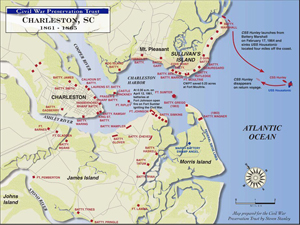 So,
Stevens got an attaboy which is what they got in the Civil War in lieu
of medals. It helped his
career as he ended his career as an admiral.
As we continue the story, they took the yacht
America
and brought her to Newport, RI where she was repaired and fitted out
with armaments and so she became
USS America.
As a sailing gunboat
USS America
was sent to Charleston, SC.
As you can see the city was lined with Confederate forts.
The gunboat was assigned the in-shore blockade.
USS America
captured several ships trying to run the blockade.
In addition, she had several duels with shore fortifications; she
served the Navy well. So,
Stevens got an attaboy which is what they got in the Civil War in lieu
of medals. It helped his
career as he ended his career as an admiral.
As we continue the story, they took the yacht
America
and brought her to Newport, RI where she was repaired and fitted out
with armaments and so she became
USS America.
As a sailing gunboat
USS America
was sent to Charleston, SC.
As you can see the city was lined with Confederate forts.
The gunboat was assigned the in-shore blockade.
USS America
captured several ships trying to run the blockade.
In addition, she had several duels with shore fortifications; she
served the Navy well.
In June of 1863
USS America
was reassigned to Boston.
You can see from the photograph some of the weapons of war on her deck.
This was a pivotal point in the Civil War.
Vicksburg and Gettysburg were about to happen.
Riots were breaking out in northern cities.
Lynchings of blacks were taking place due to the draft.
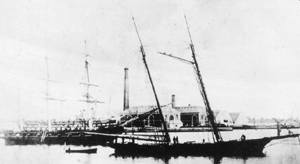 Unplanned
by the government in Richmond two lieutenants in the Confederate Navy,
stationed in the South Atlantic, began raiding the New England coast.
They sank 26 ships and plunged the entire American merchant
marine into chaos.
Insurance rates skyrocketed.
Officials from New England sent telegrams to Washington demanding
that the Navy send a fleet to New England.
Well, the Navy did send a fleet of several ships including
USS America.
However, she did not find any of the raiders.
There was an encounter off of Portland. ME.
The raiders were captured and that ended the great New England
Raid. The next station port
for
USS America
is Newport, RI. She stays
there and the Civil War ends. Unplanned
by the government in Richmond two lieutenants in the Confederate Navy,
stationed in the South Atlantic, began raiding the New England coast.
They sank 26 ships and plunged the entire American merchant
marine into chaos.
Insurance rates skyrocketed.
Officials from New England sent telegrams to Washington demanding
that the Navy send a fleet to New England.
Well, the Navy did send a fleet of several ships including
USS America.
However, she did not find any of the raiders.
There was an encounter off of Portland. ME.
The raiders were captured and that ended the great New England
Raid. The next station port
for
USS America
is Newport, RI. She stays
there and the Civil War ends.
Post war finds her in Annapolis, MD as a training ship at the United
States Naval Academy. There
she returns to racing with a crew of midshipmen.
She is still fast, but she does not win.
On August 8, 1870, the Navy entered her in the America's Cup race
at New York Harbor, where she finished fourth.
Robert went on to explain that in 1972 he raced against Navy
crewed vessels. The USNA
had a fleet of Luders 44s, a 44-foot racing yawl.
In 1873 she is put up for sale.
Yes, and a guy you all know buys her, Benjamin “Beast” Butler.
He got the yacht
America
into racing shape once again and kept her for 35 years.
Butler does not live that long but he and his family raced her.
Ben died in 1893 and the boat passed on to his son, Paul.
But he was tired of sailing such that in the early 1900s
America
was in terrible, terrible shape.
Many people were upset about that, but the family would not sell
the yacht. After Paul died
some people convinced the family that this veteran of both sides of the
Civil War should go back to the Navy.
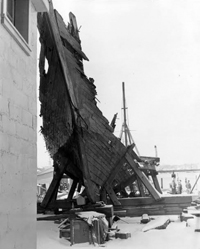 America
was sold to a company headed by Charles Foster in 1917, and in 1921 was
sold to the
America Restoration Fund,
which donated her to the U.S. Naval Academy in Annapolis.
She sits at the USNA and in the 1930s she was redesignated a Navy
vessel and given a pennant number IX-41.
The IX means experimental.
But she just sat at the dock and never raced.
President Roosevelt, a great yachtsman, wanted her renovated and
kept at Annapolis as a museum ship.
This would be similar to
USS Constitution
in Boston. The plan fell
apart on December 7, 1941.
The administration was busy during the 1930s rebuilding the navy’s
warships so there were no funds for a museum ship.
And then tragedy struck.
She was up on the “hard” when a great blizzard hit.
The shed which housed
America
collapsed during a heavy snowstorm on March 29, 1942.
The remains of the shed and ship were scrapped and burned in
1945. America
was sold to a company headed by Charles Foster in 1917, and in 1921 was
sold to the
America Restoration Fund,
which donated her to the U.S. Naval Academy in Annapolis.
She sits at the USNA and in the 1930s she was redesignated a Navy
vessel and given a pennant number IX-41.
The IX means experimental.
But she just sat at the dock and never raced.
President Roosevelt, a great yachtsman, wanted her renovated and
kept at Annapolis as a museum ship.
This would be similar to
USS Constitution
in Boston. The plan fell
apart on December 7, 1941.
The administration was busy during the 1930s rebuilding the navy’s
warships so there were no funds for a museum ship.
And then tragedy struck.
She was up on the “hard” when a great blizzard hit.
The shed which housed
America
collapsed during a heavy snowstorm on March 29, 1942.
The remains of the shed and ship were scrapped and burned in
1945.
But you can still sail on the schooner
America.
In 1995 a replica was built.
During the winter you can sail on her out of Key West, Florida.
You can sail the
America
replica today. Here is a
link to the schooner
America
in Key West:
https://sail-keywest.com/browse-by-boat/schooner-america-2-0/
Last changed: 01/29/24 |

